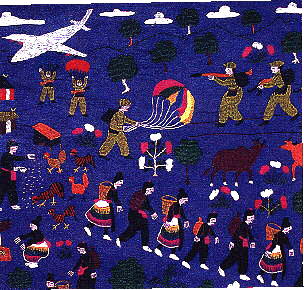Shoe Leather
Oct 9, 2008
Collective Eye's Journeys Inside Hmong Culture by Teri Tynes
I first encountered Hmong culture while living in Wisconsin in the early 1990s, and like many of the residents, I was unfamiliar with their story and cultural traditions. One way I learned more about the Hmong was seeing an exhibition of their powerful story quilts at the Priebe Gallery at the University of Wisconsin Oshkosh.
 I first encountered Hmong culture while living in Wisconsin in the early 1990s, and like many of the residents, I was unfamiliar with their story and cultural traditions. One way I learned more about the Hmong was seeing an exhibition of their powerful story quilts at the Priebe Gallery at the University of Wisconsin Oshkosh. Many of these Hmong textiles featured images of soldiers in battle, airplane raids, and attack helicopters, and underneath one could see the lines of Hmong people in traditional dress forced out of their land and making their way to a new place. While I thought I was familiar with most quilt traditions, I had never seen anything like these stitched images of contemporary warfare. Originally from China and then settled in the mountains of Laos, Thailand, and Vietnam, the Hmong were caught up in the geopolitics of the Vietnam War, especially in their roles as mercenaries under the command of the CIA, and in the aftermath of the war they were forced into camps in Thailand. While waiting immigration to the United States and other countries, they stitched journeys of warfare and displacement into these extraordinary quilts.[Image: Hmong Storycloth (detail). Artist Unknown. Collection of Susan Shapiro www.turkotek.com]
I first encountered Hmong culture while living in Wisconsin in the early 1990s, and like many of the residents, I was unfamiliar with their story and cultural traditions. One way I learned more about the Hmong was seeing an exhibition of their powerful story quilts at the Priebe Gallery at the University of Wisconsin Oshkosh. Many of these Hmong textiles featured images of soldiers in battle, airplane raids, and attack helicopters, and underneath one could see the lines of Hmong people in traditional dress forced out of their land and making their way to a new place. While I thought I was familiar with most quilt traditions, I had never seen anything like these stitched images of contemporary warfare. Originally from China and then settled in the mountains of Laos, Thailand, and Vietnam, the Hmong were caught up in the geopolitics of the Vietnam War, especially in their roles as mercenaries under the command of the CIA, and in the aftermath of the war they were forced into camps in Thailand. While waiting immigration to the United States and other countries, they stitched journeys of warfare and displacement into these extraordinary quilts.[Image: Hmong Storycloth (detail). Artist Unknown. Collection of Susan Shapiro www.turkotek.com]
Thanks to Collective Eye, producers of documentaries about social responsibility and change, the Hmong have been documented at a critical time in their adjustment to the United States. Between Two Worlds: The Hmong Shaman in America (1984) and The Split Horn: Life of a Hmong Shaman in America (2001) reveal an understanding of these relatively-recent arrivals by contextualizing the Hmong culture in American national metahistory. These documentary projects underscore the precariousness of the Hmong's cultural transition to the United States, raising concerns about the loss of their traditions and cultural identity. We're fortunate that Taggart Siegel and Dwight Conquergood set out to explore the Hmong culture in the United States in the early years of their arrival in order to document the community and traditions before too much gets lost.
Between Two Worlds: The Hmong Shaman in America (27 minutes) defines and explains shamanism by first comparing the Native American practices with those of the refugees from Southeast Asia. Like America's original settlers, the Hmong shamans believe in drawing upon knowledge of plant healing for specific remedies and cures, and they assume a close connection of human and animal life. Particularly interesting is the split within the community as Christian missionaries target the traditional Hmong for religious conversion. New concepts of sin and guilt force anxiety among members of the community. The larger cultural and psychological issues of adapting to unfamiliar values of a new country are suggested as a possible cause for the high rate of sudden death syndrome. The Split Horn: Life of a Hmong Shaman in America (2001) continues the focus through a portrait of one particular shaman.
Additional works in the Collective Eye collection include Blue Collar and Buddha (1987; 57 minutes), a particularly relevant film that examines the hostility among blue-collar workers and their resistance, including physical violence, to the building of a Buddhist temple outside Rockford, Illinois. The resentment is partially fueled by the economic recession of 1987. It's a brutally honest portrayal of reactionary sentiment. Also recommended - The Heart Broken in Half (1990), a rare glimpse into urban street gangs, Body Memories (1993), a fairytale "about a boy who could not smile," featuring a nice performance by Sky Yaeger, and The Real Dirt on Farmer John (2005), a portrait of one radical farmer’s conflicts with the people he tried to help.